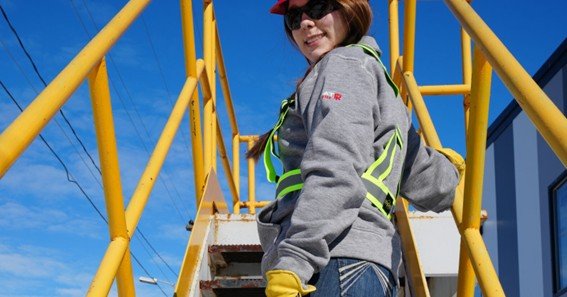If you’re exploring workwear options that combine comfort, style, and safety, an FR sweater (flame-resistant sweater) could be the ideal choice. These specialized garments are designed to protect you from fire-related hazards without sacrificing warmth or professional appearance.
In industries like oil and gas, manufacturing, or electrical work, an FR sweater can offer invaluable protection against sudden flash fires, arc flashes, or other thermal incidents. In this comprehensive guide, we’ll discuss how FR sweaters function, the standards they adhere to, and key factors you should consider before making a purchase.
Why Choose an FR Sweater Over Regular Workwear?
Flame-resistant sweaters differ from standard clothing due to their material composition and safety certifications. Here’s why they’re a cut above the rest:
-
Safety Compliance
FR sweaters are designed to meet specific industry standards (such as NFPA 70E for arc flash protection or NFPA 2112 for flash fire protection). These standards ensure the garment can self-extinguish once the ignition source is removed. -
Enhanced Warmth
Unlike traditional FR shirts, sweaters provide additional insulation, making them useful in cooler climates or indoor facilities prone to drafts. -
Comfort & Durability
High-quality FR sweaters are engineered using materials that maintain flexibility and breathability. This ensures you stay comfortable even in demanding work environments. -
Professional Appearance
From on-site meetings to casual company events, FR sweaters come in various cuts and styles that blend safety with a polished look.
1. Key Features of an FR Sweater
-
Material Composition
Flame-resistant sweaters typically use fabrics like modacrylic, aramid, or treated cotton blends that meet required safety standards. -
Multifunctional Design
Many FR sweaters feature ribbed cuffs or hems to help retain heat while maintaining a tailored fit. -
Moisture-Wicking & Breathability
Modern FR fabrics often include moisture-wicking properties to prevent overheating during strenuous tasks. -
Layering Capabilities
FR sweaters can be worn over other flame-resistant layers without compromising the overall safety rating. This ensures consistent protection in unpredictable temperatures.
2. Industry Standards & Certifications
-
NFPA 70E (Arc Flash)
Specifies the guidelines for electrical safety in the workplace. An FR sweater with an arc rating (measured in cal/cm²) can protect workers from arc flashes. -
NFPA 2112 (Flash Fire)
Outlines the performance requirements for flame-resistant clothing intended to protect against short-duration thermal exposures. -
ASTM F1506
Requires FR garments to meet certain criteria for flame-resistance, ensuring that they won’t ignite, melt, or drip under specific testing conditions.
Always check labels and product descriptions to verify which standards your FR sweater meets.
3. Choosing the Right FR Sweater: Factors to Consider
-
Arc Rating/ATPV
Look for the garment’s Arc Thermal Performance Value (ATPV), which indicates the amount of thermal protection it offers against arc flash hazards. -
Fit & Comfort
Ensure the sweater fits properly—too loose or too tight can affect both safety and ease of movement. -
Workplace Requirements
Some workplaces have minimum arc ratings, specific industry certifications, or style guidelines. Always confirm compliance with your employer’s rules. -
Seasonal Needs
If you need year-round protection, consider layering your sweater with lighter FR garments in warmer months. -
Maintenance & Care
FR fabrics require specific laundering methods (e.g., avoiding bleach or fabric softeners). Review the care instructions to maintain the sweater’s protective qualities.
4. Maintenance Tips
-
Follow manufacturer’s Instructions:
Each FR sweater comes with washing guidelines—adhere to them strictly to preserve flame-resistant properties. -
Avoid Harsh Chemicals:
Bleach, fabric softeners, or detergents with enzymes can degrade the garment’s FR treatment. -
Inspect Regularly:
Keep an eye out for rips, frayed seams, or worn areas. Damage could reduce the sweater’s protective performance. -
Retire When Necessary:
If you notice irreparable damage or the garment’s arc rating label becomes unreadable, consider replacing it to ensure continued safety.
5. Top Situations Where an FR Sweater Is Essential
-
Electrical Maintenance Work:
Electricians or maintenance workers facing potential arc flash hazards benefit greatly from an FR sweater’s protective barrier. -
Refinery & Chemical Plants:
Potential flash fire incidents require clothing that self-extinguishes once the ignition source is removed. -
Construction Sites in Cold Regions:
Outdoor tasks in chilly climates can demand both warmth and flame resistance. -
Emergency Response Teams:
Some first responders and industrial rescue personnel may need protection from unforeseen thermal events.
Frequently Asked Questions
-
Can an FR sweater replace all my other FR garments?
Not necessarily. An FR sweater provides added warmth and protection, but layering with FR shirts or pants can enhance overall safety in more extreme conditions. -
Is an FR sweater machine-washable?
Most FR sweaters are machine-washable, but it’s crucial to follow the manufacturer’s instructions regarding water temperature, detergent type, and drying settings. -
How long does the flame-resistant treatment last?
Many modern FR fabrics are inherently flame-resistant, meaning the properties don’t wash out over time. However, treatments on certain fabrics can degrade, so always verify with the product label. -
Do FR sweaters come in different styles and colors?
Yes. While safety is the top priority, many brands offer multiple designs, colors, and fits to accommodate personal preferences and workplace dress codes. -
Is an FR sweater comfortable to wear all day?
High-quality FR sweaters are designed to be both protective and comfortable. Look for models that emphasize breathability and a soft inner lining for extended wear.










